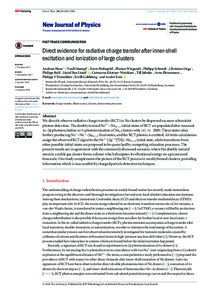Datum
2018-01-16Autor
Hans, AndreasStumpf, VasiliHolzapfel, XaverWiegandt, FlorianSchmidt, PhilippOzga, ChristianReiß, PhilippBen Ltaief, LtaiefKüstner-Wetekam, CatmarnaJahnke, TillEhresmann, ArnoDemekhin, Philipp V.Gokhberg, KirillKnie, AndréSchlagwort
530 PhysikMetadata
Zur Langanzeige
Aufsatz
Artikel (Publikationen im Open Access gefördert durch die UB)

Direct evidence for radiative charge transfer after inner-shell excitation and ionization of large clusters
Zusammenfassung
We directly observe radiative charge transfer (RCT) in Ne clusters by dispersed vacuum-ultraviolet photon detection. The doubly ionized Ne^2+ – Ne_n-1 initial states of RCT are populated after resonant 1s–3p photoexcitation or 1s photoionization of Ne_n clusters with {n} \approx 2800. These states relax further producing Ne^+ – Ne^+ – Ne_n-2 final states, and the RCT photon is emitted. Ab initio calculations assign the observed RCT signal to the Ne^2+(2p^-2 [^1D]) - Ne_n-1 initial state, while transitions from other possible initial states are proposed to be quenched by competing relaxation processes. The present results are in agreement with the commonly discussed scenario, where the doubly ionized atom in a noble gas cluster forms a dimer which dissipates its vibrational energy on a picosecond timescale. Our study complements the picture of the RCT process in weakly bound clusters, providing information which is inaccessible by charged particle detection techniques.
Zitierform
In: New Journal of Physics. - London : IOP. - 20(2018) 012001Förderhinweis
Gefördert durch den Publikationsfonds der Universität KasselSammlung(en)
Publikationen (Experimentalphysik IV - Funktionale dünne Schichten & Physik mit Synchrotronstrahlung)Artikel (Publikationen im Open Access gefördert durch die UB)
Zitieren
@article{urn:nbn:de:hebis:34-2018020654495,
author={Hans, Andreas and Stumpf, Vasili and Holzapfel, Xaver and Wiegandt, Florian and Schmidt, Philipp and Ozga, Christian and Reiß, Philipp and Ben Ltaief, Ltaief and Küstner-Wetekam, Catmarna and Jahnke, Till and Ehresmann, Arno and Demekhin, Philipp V. and Gokhberg, Kirill and Knie, André},
title={Direct evidence for radiative charge transfer after inner-shell excitation and ionization of large clusters},
year={2018}
}
0500 Oax 0501 Text $btxt$2rdacontent 0502 Computermedien $bc$2rdacarrier 1100 2018$n2018 1500 1/eng 2050 ##0##urn:nbn:de:hebis:34-2018020654495 3000 Hans, Andreas 3010 Stumpf, Vasili 3010 Holzapfel, Xaver 3010 Wiegandt, Florian 3010 Schmidt, Philipp 3010 Ozga, Christian 3010 Reiß, Philipp 3010 Ben Ltaief, Ltaief 3010 Küstner-Wetekam, Catmarna 3010 Jahnke, Till 3010 Ehresmann, Arno 3010 Demekhin, Philipp V. 3010 Gokhberg, Kirill 3010 Knie, André 4000 Direct evidence for radiative charge transfer after inner-shell excitation and ionization of large clusters / Hans, Andreas 4030 4060 Online-Ressource 4085 ##0##=u http://nbn-resolving.de/urn:nbn:de:hebis:34-2018020654495=x R 4204 \$dAufsatz 4170 7136 ##0##urn:nbn:de:hebis:34-2018020654495
<resource xsi:schemaLocation="http://datacite.org/schema/kernel-2.2 http://schema.datacite.org/meta/kernel-2.2/metadata.xsd"> 2018-02-06T13:43:39Z 2018-02-06T13:43:39Z 2018-01-16 1367-2630 urn:nbn:de:hebis:34-2018020654495 http://hdl.handle.net/123456789/2018020654495 Gefördert durch den Publikationsfonds der Universität Kassel eng Urheberrechtlich geschützt https://rightsstatements.org/page/InC/1.0/ charge transfer fluorescence clusters interatomic processes 530 Direct evidence for radiative charge transfer after inner-shell excitation and ionization of large clusters Aufsatz We directly observe radiative charge transfer (RCT) in Ne clusters by dispersed vacuum-ultraviolet photon detection. The doubly ionized Ne^2+ – Ne_n-1 initial states of RCT are populated after resonant 1s–3p photoexcitation or 1s photoionization of Ne_n clusters with {n} \approx 2800. These states relax further producing Ne^+ – Ne^+ – Ne_n-2 final states, and the RCT photon is emitted. Ab initio calculations assign the observed RCT signal to the Ne^2+(2p^-2 [^1D]) - Ne_n-1 initial state, while transitions from other possible initial states are proposed to be quenched by competing relaxation processes. The present results are in agreement with the commonly discussed scenario, where the doubly ionized atom in a noble gas cluster forms a dimer which dissipates its vibrational energy on a picosecond timescale. Our study complements the picture of the RCT process in weakly bound clusters, providing information which is inaccessible by charged particle detection techniques. open access In: New Journal of Physics. - London : IOP. - 20(2018) 012001 Hans, Andreas Stumpf, Vasili Holzapfel, Xaver Wiegandt, Florian Schmidt, Philipp Ozga, Christian Reiß, Philipp Ben Ltaief, Ltaief Küstner-Wetekam, Catmarna Jahnke, Till Ehresmann, Arno Demekhin, Philipp V. Gokhberg, Kirill Knie, André doi:10.1088/1367-2630/aaa4af </resource>
Die folgenden Lizenzbestimmungen sind mit dieser Ressource verbunden:
Urheberrechtlich geschützt

